9 Trombone Articulation Exercises — Mastering Precision and Control For Beginners
Original price was: $0.65.$0.00Current price is: $0.00.
This comprehensive set of 9 trombone articulation exercises covers a wide range of techniques, from basic patterns to advanced tongue coordination. Designed for players of all levels, these exercises aim to improve precision, control, and overall trombone playing skills.
Description
Trombone articulation exercises are the secret weapon for trombone players looking to elevate their performance (trust me, I’ve seen countless students transform their playing with these). These drills help you master the art of shaping notes, controlling airflow, and coordinating your tongue and slide movements. Whether you’re a beginner finding your footing or an advanced player honing your craft, these exercises are essential for developing a clean, precise, and expressive trombone technique.
The exercises suit players of all levels, though beginners might need to take them at a slower tempo initially. Remember, the goal is consistency and clarity, not speed (I always tell students, “Slow and steady WINS the race!!”).
MusicSheetViewerPlugin 4.1Trombone Articulation Exercises — Sheet Music Overview
This comprehensive set of articulation exercises covers various aspects of trombone technique. The sheet music is divided into nine distinct exercises, each focusing on different articulation patterns and skills. Here’s a quick rundown:
- Basic articulation patterns (Exercise 1-2)
- Staccato and legato contrasts (Exercise 3-4)
- Flutter tongue drill (Exercise 5)
- Attacks and releases (Exercise 6)
- Repeated tonguing (Exercise 7)
- Tongue slide coordination (Exercise 8)
- Advanced tongue coordination (Exercise 9)
The exercises are primarily in B-flat major, in 4/4 time signatures. Tempo markings range from 72 to 88 PBM (beats per minute) for gradual speed increases as you improve.
Trombone Articulation Exercises — Step-by-Step Breakdown of the Exercises
Let’s break down each exercise and how to approach them:
- **Basic Articulation Patterns (Exercise 1-2)**
- Start with long, sustained notes using different articulation markings.
- Focus on clean attacks and a consistent tone throughout each note.
- Practice transitioning between different articulation styles smoothly.
- **Staccato and Legato Contrasts (Exercise 3-4)**
- Alternate between short, detached notes (staccato) and smooth, connected notes (legato).
- Maintain even air support throughout both styles.
- Pay attention to the space between staccato notes without cutting them too short.
- **FluttertongueDrill (Exercise 5)**
- Roll your tongue while blowing to create a “flutter” effect.
- Start slowly and gradually increase speed as you become comfortable.
- Focus on maintaining a steady air stream throughout the exercise.
- **Attacks and Releases (Exercise 6)**
- Practice precise beginnings and endings of notes.
- Aim for clean, immediate starts without “fuzzy” attacks.
- Release notes cleanly without abrupt cutoffs or “tailing” sounds.
- **Repeated Tonguing (Exercise 7)**
- Develop quick, light tongue movements for rapid articulation.
- Keep your tongue relaxed and use minimal motion.
- Maintain consistent air support to prevent notes from weakening.
- **Tongue Slide Coordination (Exercise 8)**
- Synchronize your tongue articulation with slide movements.
- Practice in all keys to improve flexibility across the instrument’s range.
- Focus on smooth slide transitions between notes.
- **AdvancedTongue Coordination (Exercise 9)**
- Combine various articulation patterns in a challenging exercise.
- Pay attention to the specific articulation markings for each note.
- Gradually increase tempo as your coordination improves.
Remember, the key to mastering these exercises is consistent, focused practice. Start slowly and prioritize accuracy over speed (I always say, “Practice doesn’t make perfect; perfect practice makes perfect!”).
Trombone Articulation Exercises — Technical Detail and Musical Analysis
These articulation exercises are designed to develop several crucial aspects of trombone playing:
- **Tongue Control** — The exercises help refine the player’s ability to use their tongue efficiently for articulation. This includes developing speed, precision, and the ability to switch between different articulation styles seamlessly.
- **Air Support** — Consistent air flow is essential for maintaining tone quality across different articulation patterns. These exercises challenge players to maintain steady air support, especially during rapid tonguing passages.
- **Slide Technique** — Exercises like the Tongue Slide Coordination drill (Exercise 8) focus on synchronizing slide movements with articulation, a crucial skill for trombone players.
- **Dynamic Control** — While not explicitly marked, these exercises provide opportunities to practice articulation at various dynamic levels, enhancing overall expressive capabilities.
- **Rhythmic Precision** — The repeated patterns and varied note lengths help develop a strong sense of timing and rhythmic accuracy.
From a music theory perspective, the exercises primarily use diatonic patterns in B-flat major, with some chromatic elements introduced in later exercises. This approach allows players to focus on articulation technique while working within a familiar tonal framework.
The progression of exercises from basic sustained notes to more complex patterns reflects a well-structured pedagogical approach, gradually building the player’s skills and confidence (it’s like building a house – you need a solid foundation before adding the fancy stuff!).
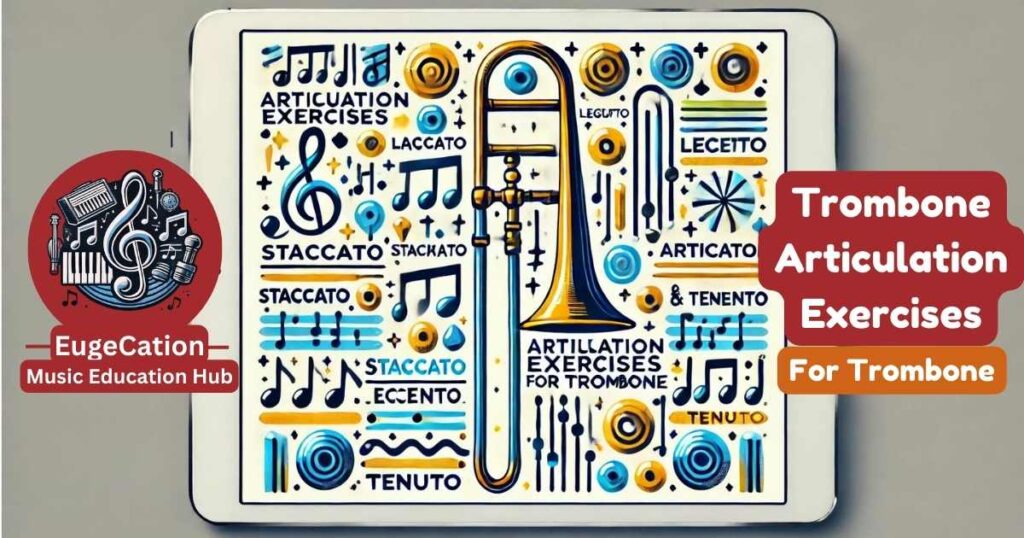
Trombone Articulation Exercises — Common Challenges and How to Overcome Them
- **Inconsistent Articulation**
- Challenge — Producing clean, consistent articulation across all registers.
- Solution — Practice slow, deliberate tonguing exercises, focusing on clarity in each register. Gradually increase speed as consistency improves.
- **Coordination Between Tongue and Slide**
- Challenge — Synchronizing tongue movements with slide positions, especially in fast passages.
- Solution — Practice slide movements without tonguing, then slowly incorporate articulation. Use a metronome to ensure precise timing.
- **Maintaining Air Support**
- Challenge — Keeping a steady air stream during rapid articulation passages.
- Solution — Practice long tones to develop breath control, then apply this to articulation exercises. Focus on continuous air flow, even during staccato notes.
- **Fatigue During Extended Practice**
- Challenge — Tongue and embouchure fatigue during long practice sessions.
- Solution — Take regular breaks, practice in shorter, focused sessions, and gradually build endurance over time.
- **Achieving Clarity in Different Articulation Styles**
- Challenge — Distinguishing between legato, staccato, and other articulation markings.
- Solution — Exaggerate the differences between styles initially, then refine for more subtle distinctions. Listen to recordings of professional players for reference.
Remember, overcoming these challenges takes time and patience. Consistent, focused practice is key (Rome wasn’t built in a day, and neither is great trombone technique!).
Trombone Articulation Exercises — Tips for Effective Practice
- Start SLOW and gradually increase tempo as accuracy improves.
- Use a metronome to maintain steady rhythm and timing.
- Practice in front of a mirror to observe your embouchure and slide technique.
- Record yourself and listen back to identify areas for improvement.
- Alternate between focused, short practice sessions and longer endurance-building sessions.
- Incorporate articulation exercises into your daily warm-up routine.
- Experiment with different dynamic levels to improve control and expression.
Remember, the tongue doesn’t produce the note – it only shapes it. Focus on maintaining a steady air stream and let the tongue guide the air (think of your air as a river and your tongue as the banks shaping its flow).
Trombone Articulation Exercises — How These Exercises Benefit Overall Trombone Playing
Mastering these articulation exercises significantly enhances your overall trombone playing:
- **Improved Phrasing** — Clean articulation allows for more expressive and nuanced phrasing in all musical styles.
- **Enhanced Technical Facility** — The coordination developed through these exercises translates to better overall technique, especially in fast or complex passages.
- **Greater Versatility** — Proficiency in various articulation styles enables you to adapt to different musical genres and ensemble settings.
- **Better Tone Quality** — Consistent air support and precise articulation contribute to a fuller, more resonant tone across all registers.
- **Increased Endurance** — REGULAR practice of these exercises builds stamina in both your embouchure and tongue muscles!!
These skills are essential whether you’re playing jazz, classical, or any other genre. As renowned trombonist Joseph Alessi once said, “Articulation is the clarity of musical speech” (and who doesn’t want to speak clearly?).
Trombone Articulation Exercises — Related Exercises and Next Steps
To complement these articulation exercises, consider incorporating:
- “ Long tone” exercises to improve breath control for beginner and intermediate players
- Trombone Scale Chart in PDF — patterns to enhance finger dexterity and slide technique
- “Trombone Lip Slurs” — 2-page beginner essential warm-ups
- “5 Beginner Trombone Flexibility Exercises” — Master trombone slur notes without slide
For prerequisites, ensure you have a solid foundation in basic trombone technique and breath support before diving deep into these articulation exercises.
Remember, consistent practice is key to improvement. As you master these exercises, you’ll notice a significant enhancement in your overall trombone playing. Keep at it, and don’t forget to enjoy the process! (After all, music should be fun, right?)
Additional information
| Instrument | Trombone |
|---|---|
| Level | Beginner, Intermediate |
| Type | Sheet Music |




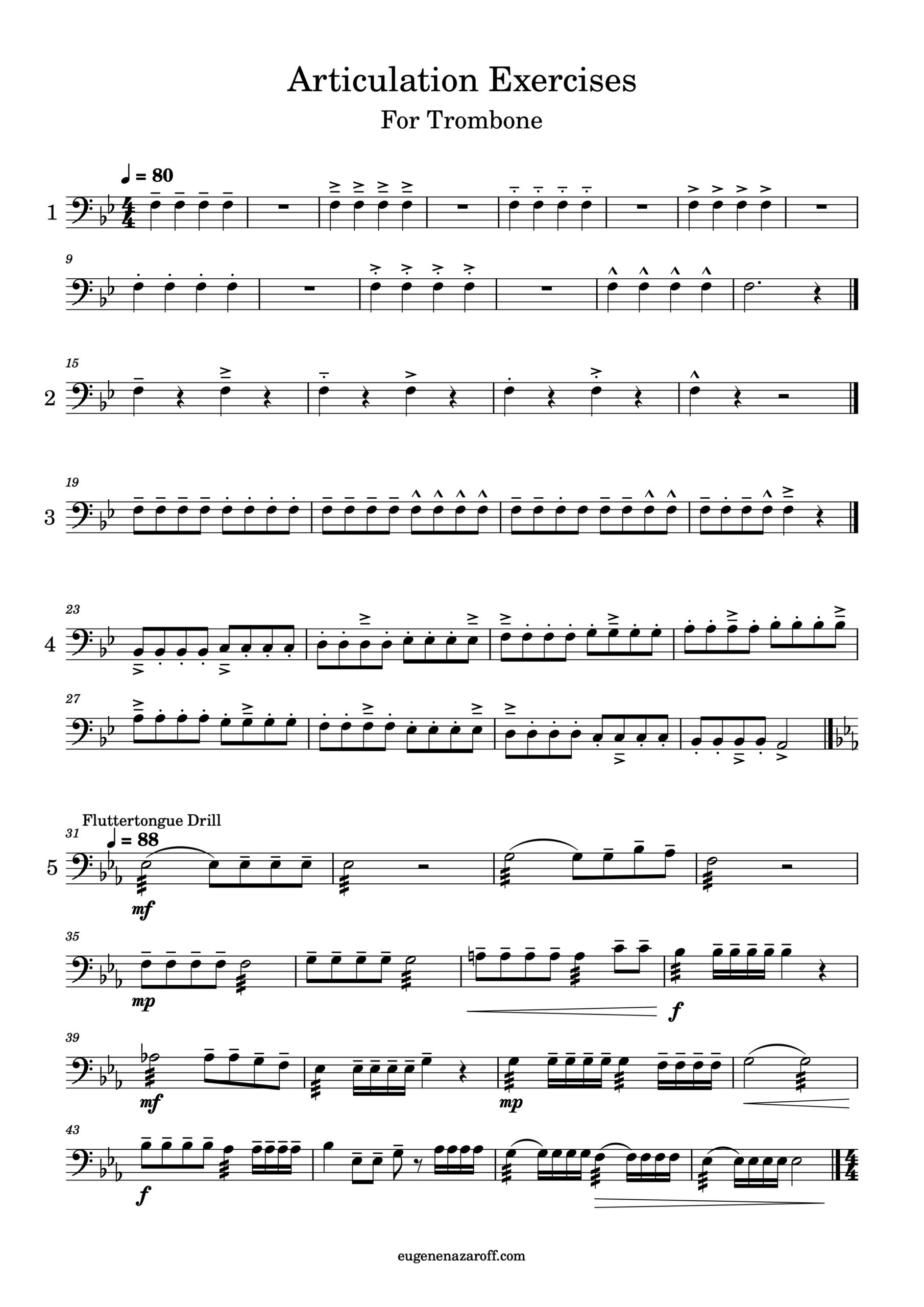
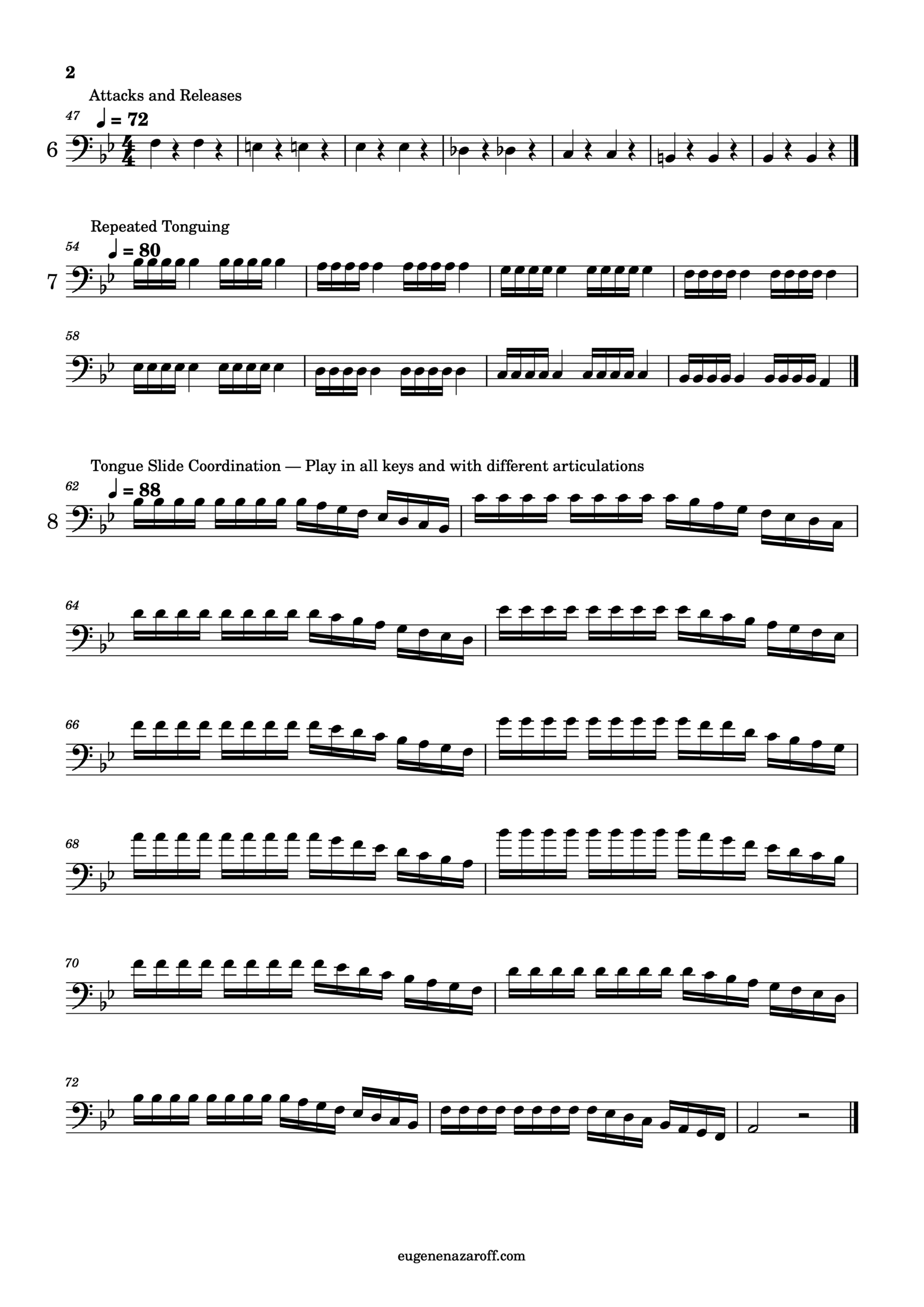
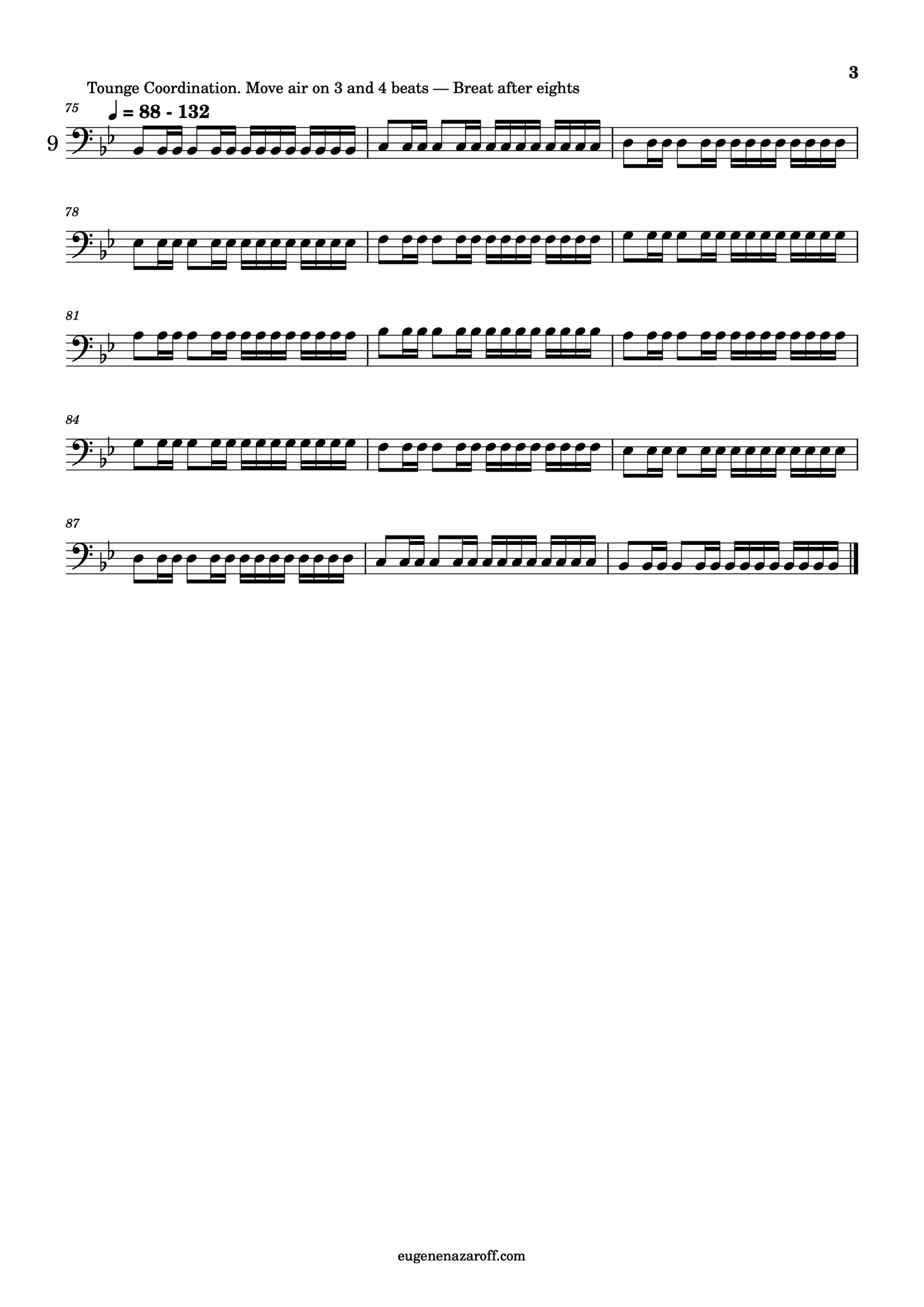
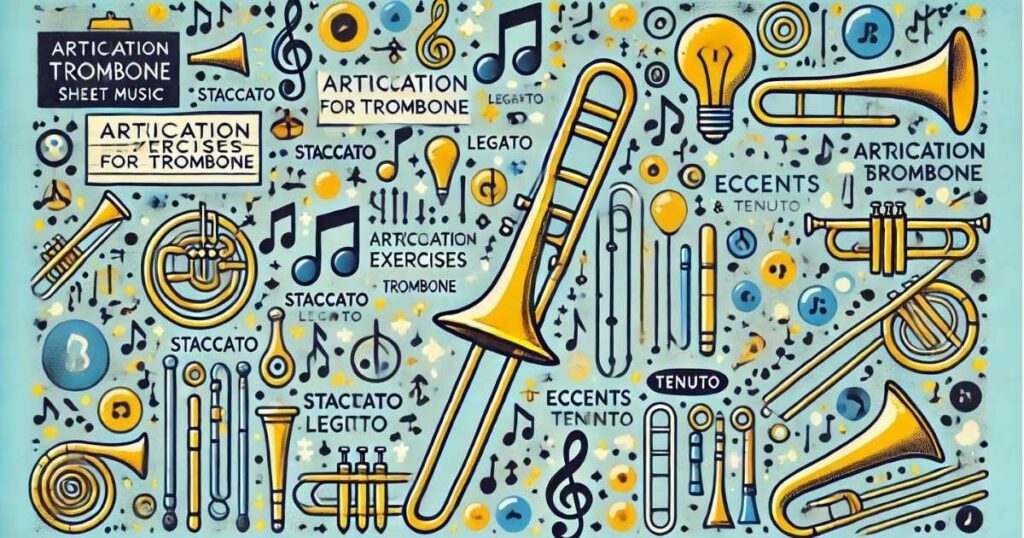
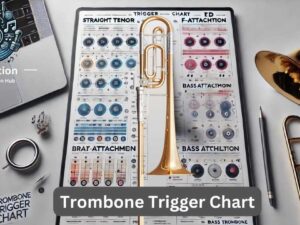
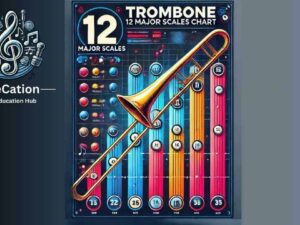


Reviews
There are no reviews yet.